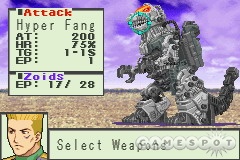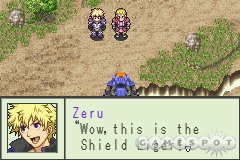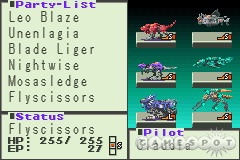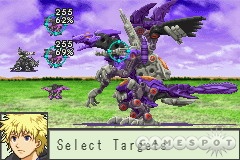Zoids are mechanical toy robots that resemble animals and dinosaurs. What makes them unique is that they have interchangeable parts that make it possible to come up with thousands of different robot-and-weapon combinations. The toy line has been around off and on for more than 20 years--going strong in Japan since 1982--but the concept didn't really take off in the West until the recent animated series started airing on syndicated television. In the animated series, young pilots build Zoids and take them into battles against other Zoids pilots, for the purpose of winning championships and stopping bandit pilots who're up to no good. If you think that sounds a lot like Nintendo's Pokémon, you're right, and the parallels only get stronger in Zoids: Legacy, a role-playing game for the Game Boy Advance that merely does a so-so job of continuing the story started in the animated series, but succeeds wonderfully at allowing players to collect, equip, and battle hundreds of different Zoids along the way.

The game's story revolves around a rookie pilot named Zeru, who wakes up one day in a strange land populated by robotic creatures called Zoids. Zeru learns about the Zoids tournaments in the first village he stops in, and a helpful scientist gives Zeru a robot of his own to use in the competitions. After participating in his first tournament, Zeru meets a female Zoids pilot named Juno, who, in addition to being a stranger to this new world herself, happens to have lost her memory. Things snowball from there. Juno gets kidnapped by a mob of evil Zoids pilots and, while wandering from one village to the next trying to find her, Zeru meets a man named Dr. T who informs him about a cosmic calamity that has caused past, present, and future to fuse together into a single world. The key to solving all these problems, it seems, is to obtain as many Zoids as possible. The story isn't as family-friendly or as comprehensible as the adventures that Ash, Pikachu, and Professor Oak embark upon in the Pokémon games, but the chain of events does at least keep players pointed in the right direction while exploring the truly massive Zoids gameworld.
While the game does provide different villages to visit and different people to talk to in order to advance the story, the whole purpose behind it is to collect, equip, and upgrade your own army of Zoids to use against CPU opponents or friends who also happen to own the game. Instead of capturing new Zoids, which is how things are done in the Pokémon games, you'll collect the data crystals and parts left behind by the Zoids you defeat in battle. Such items can then be turned into new Zoids by visiting one of the labs located in each village. These labs also let you repair demolished Zoids and upgrade the offensive strength, armor, and power output of the Zoids already in your possession. Zoids, like Pokémon, can use their claws, fangs, and tails to attack enemies on the battlefield, but you also have the option of attaching different weapons and armor to your Zoids to expand their attack capabilities. Weapons such as machine guns, plasma cannons, and missiles can dole out a great deal of damage and often hit multiple enemies at once, and accessories such as armor plating, radar arrays, and missile sensors let you improve attributes such as defense, hit rate, and evasion speed. The number of different weapons and accessories you can attach to each robot is limited by its carrying power and energy output. Generally speaking, smaller Zoids can't carry as many weapons as larger Zoids.

The battles in Zoids: Legacy are handled in a turn-based fashion, which is, again, similar to the way things are done in Nintendo's Pokémon games, but the battle system allows for a much greater variety of customization and strategy than you'll find in Nintendo's series. Instead of limiting battles to one-on-one or two-on-two, the matchups in Zoids: Legacy can be as large as six-on-six, just so long as you have enough Zoids and pilots to bring into battle. And that's not a major problem, since Zeru is constantly running into available pilots during the story mode. Team formation also plays a major role in the outcome of battles. Both sides of the battlefield are separated into a two-by-three grid. Zoids situated in the front row can use their claws, fangs, and tails to attack, in addition to the weapons they're equipped with, while Zoids in the back row are limited to using only the guns and missile packs that they've been outfitted with. Zoids in the front row also get a speed bonus that lets them attack sooner, while Zoids in the back row get an evasion bonus that helps them dodge attacks. Additionally, you can put larger Zoids in front to shield weaker ones from direct attacks, or stagger your Zoids to make it tougher for the opponent to hit you with attacks that target adjacent horizontal or vertical pairs.
Combat is fairly straightforward, but there are a few things to keep in mind at each step of the process. Before each round of turns begins, you have the option of giving what's called a deck command. Deck commands affect the entire team and run the gamut from increasing the amount of cash or parts you get after a battle to refilling the team's hit points or giving you the ability to temporarily fuse multiple Zoids together into a single supersized robot. The various characters you meet throughout the story mode will add to the number of different deck commands you can give. After you choose whether or not to give a deck command, it's time to trade turns with the opponent. During a turn, each unit can perform one of three actions: launch an attack, wait a turn to gain additional energy points, or use an item from the inventory. Certain characters in the game have robotic companions that tag along with them, called organoids, that can merge with a Zoids robot during a battle and greatly increase its hit points and its offensive and defensive characteristics. If one of your Zoids pilots has an organoid in its possession, a fourth option will appear on the turn screen, labeled "organoid," that lets you use up a turn to trigger its effect.
Picking the attack command takes you to a screen that lets you choose which of your robot's various weapons to attack with. The amount of damage each weapon can inflict, the number of energy points it will consume, and a percentage noting the odds that it'll hit the target are shown in the information box for each weapon. The number of hit points the enemy robot has is also displayed on the screen, along with an overall percentage that merges the enemy's evasion rating with the hit percentage of the weapon you intend to use. In general, you can figure out how many hit points an attack will take away from the target by multiplying this overall percentage by the number of damage points the weapon is capable of inflicting. After a robot takes a turn, the next robot in line (based on overall speed ratings) will go, and, after each robot has had a turn, the round ends, at which point you'll be able to give another deck command and start the whole process over again. When a robot's hit points are gone, it's knocked out of the battle and can't be used again until it's been repaired at a lab. The battle is over when all the Zoids on one side are defeated.

In Nintendo's Pokémon games, each monster has an elemental affinity that makes it strong or weak against certain attacks. Water is strong against fire but weak against electricity, fire is strong against plants but weak against water, electricity is strong against water but not against plants, and so on. Zoids: Legacy has a similar system of strengths and weakness. Flying Zoids aren't hurt as much by standard guns or missiles as they are weapons with an antiaircraft designation. Swimming Zoids can withstand attacks from laser weapons and antiaircraft weapons really well, but don't do as well against torpedoes or body-based weapons such as fangs and claws. Tank-style Zoids are practically impervious to antiair, laser, and plasma weapons, but concussive weapons such as missiles and cannons work just fine against them. Like in Pokémon, the best way to put together a team is to put something of everything into it--a variety of ground-, air-, and sea-based Zoids with a variety of different weapons.
The biggest negative going against the way battles play out in Zoids: Legacy is that they're so time-consuming. You have to go through a number of steps just to have a single unit attack: First, you have to decide whether to attack, wait, or use an item. Then, you have to select which weapons to use and confirm the selections. Next, you have to sit through three different animations before the game finally takes off the hit points from the attack. It takes all that to make one unit do its business, and each battle typically involves 10 or 12 units and three or four rounds of turns. Some players also won't like how random battles against wild Zoids on the overworld are used to slow the trip from one village to the next, even though, to the game's credit, they are a great way to earn money and collect Zoid parts.
Otherwise, the main thing that Atari neglected to do with Zoids: Legacy is give it the same degree of refinement and polish that Nintendo adds to its Pokémon games. There isn't much to do on the overworld map except battle wild Zoids and travel between villages. On a similar note, the graphics used to draw the overworld map and villages are of the top-down 2D variety, without much at all in the way of cute details or environmental animation, which makes those portions of the game seem generic and impersonal. The music and sound effects are forgettable and at times downright painful. In particular, the high-pitched notes in the music are held so long that it feels like the game is giving you a free hearing test. The story isn't very interesting or exciting either, mainly because it's told in a very matter-of-fact way, but also because some of the dialogue is poorly translated and doesn't make sense. The Zoids battles are pretty fun to watch, though, which is the important thing. Each robot is shown from a side view during the attack phase, and you can actually see the weapons you've mounted to them attached to points on their sides, shoulders, or backs. Attacks are played out in Advance Wars-style cutaways that show the attacking robot launching its weapons and the defending robot either getting out of the way or taking the full brunt of the assault. The smoke trails that follow missiles and the accompanying explosions are very satisfying.

Zoids: Legacy has a lot to offer the Zoids enthusiast. The story mode spans 40 villages spread across three massive continents, and it includes 151 different base Zoids to collect and modify. It'll take most players approximately 30 hours to finish the story mode. Besides the story mode, there's also a challenge mode, which offers 50 increasingly tough battles, and a multiplayer mode, in which two players can join two copies of the game together using a link cable to participate in Zoids battles or trade Zoids and Zoids parts.
Ultimately, Zoids: Legacy is best suited to those who are already fans of the toys or animated series. The game does a masterful job of allowing players to collect and put together an army of unique and powerful robots, but it falls short at providing a cohesive or memorable role-playing experience.